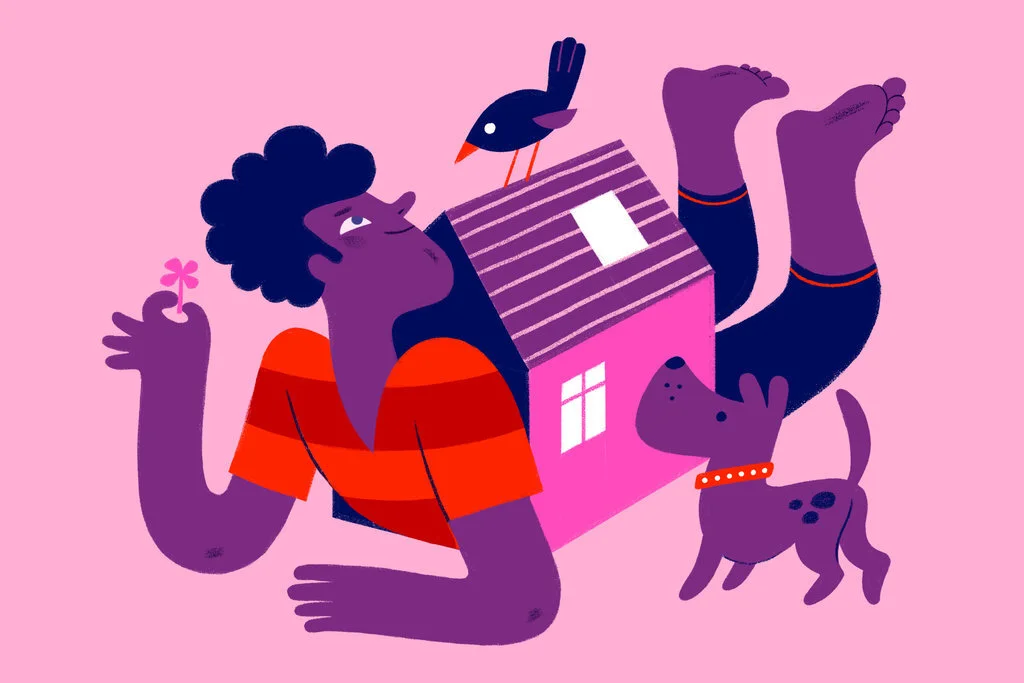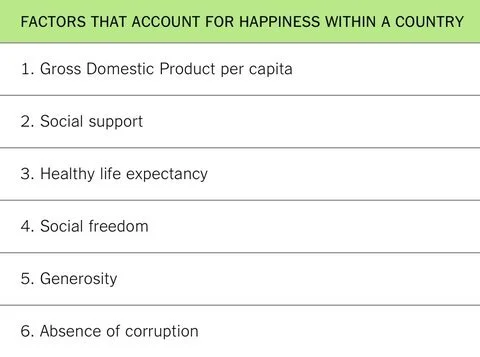Finding Your Happy Place
Finding Your Happy Place
Imagine a ladder, with steps numbered from zero at the bottom to 10 at the top. The top of the ladder represents the best possible life for you and the bottom of the ladder represents the worst possible life for you. On which step of the ladder would you say you personally feel you stand at this time?
This so-called happiness ladder is famously used as a way to measure and compare happiness across the globe. The “World Happiness Report” ranks countries based on the subjective well-being and happiness of people who live there and their responses to the ladder test. Here are the 10 happiest countries on Earth:
Countries you’d expect to be happy — those with strong economies and quality of life — are still pretty happy, even though many fell short of the top 10 and could improve policies to make their citizens even happier. The United States (6.892) is ranked 19. France (6.592) ranked 24. Japan (5.886) was 58.
The least happy places on Earth are not surprising. They tend to be countries that have experienced war, natural disasters and hardship: 152. Rwanda (3.334) 153. Tanzania (3.231) 154. Afghanistan (3.203) 155. Central African Republic (3.083) 156. South Sudan (2.853).
One thing we’ve learned from the happiness report is that there are six variables that explain differences in human happiness across countries:
The research is intended for use at the public policy level, but there are lessons to learn at the personal level as well. Find a sustaining and satisfying job; do your best to live in a happy place; surround yourself with social support; take care of your health; and be generous (in spirit, time and money) in order to pave your own personal road to happiness.
Choosing a Happy Community
What factors make a community a place where people are happy? The Knight Foundation and Gallup interviewed 43,000 people in 26 communities to find out.
Openness: People are happy when they live in a community that is welcoming to all.
Beauty: Living in a scenic, picturesque or charming community, with lots of trees and green space, makes people happier.
Social opportunities: When a community is designed to foster social connections — restaurants, community spaces, sidewalks, trails and other public spaces — people are happier.
The lesson is that where you live can have a profound effect on your happiness. If you don’t fit in, if you don’t know your neighbors, if walking outside doesn’t put a spring in your step — find a new place to live if you can afford it. Explore new neighborhoods, rent before you buy, talk to friends, talk to potential neighborhoods and relocate your way to a happier life. The key, says Jay Walljasper, author of “How to Design Our World for Happiness,” is to find a place where neighbors can encounter each other spontaneously. Look for neighborhoods with a green commons, sidewalks, parks, street festivals and community gatherings. If you’re in the city, choose an apartment with a shared backyard or a street known for its Halloween festival or a community newsletter. Look for signs that the people there are connected and create opportunities to connect with each other on a regular basis.
Spend Time in Nature
Numerous studies support the notion that spending time in nature is good for you. We know that walking on quiet, tree-lined paths can result in meaningful improvements to mental health, and even physical changes to the brain. Nature walkers have “quieter” brains: scans show less blood flow to the part of the brain associated with rumination. Some research shows that even looking at pictures of nature can improve your mood.
Sunlight also makes a difference. Seasonal affective disorder is real. Epidemiological studies estimate that its prevalence in the adult population ranges from 1.4 percent (Florida) to 9.7 percent (New Hampshire). Natural light exposure — by spending time outside or living in a space with natural light — is good for your mood.
Declutter (But Save What Makes You Happy)
Getting organized is unquestionably good for both mind and body — reducing risks for falls, helping eliminate germs and making it easier to find things like medicine and exercise gear.
Excessive clutter and disorganization are often symptoms of a bigger health problem. People who have suffered an emotional trauma or a brain injury often find housecleaning an insurmountable task. Attention deficit disorder, depression, chronic pain and grief can prevent people from getting organized or lead to a buildup of clutter. At its most extreme, chronic disorganization is called hoarding, a condition many experts believe is a mental illness in its own right, although psychiatrists have yet to formally recognize it. While hoarders are a minority, many psychologists and organization experts say the rest of us can learn from them. The spectrum from cleanliness to messiness includes large numbers of people who are chronically disorganized and suffering either emotionally, physically or socially.
The chronically-messy person can change through behavioral therapy or with guidance from numerous self-help books on the topic. The goal, says the happiness guru Gretchen Rubin, is to free yourself from the weight of meaningless clutter but still surround yourself with useful, beloved things, ranging from a child’s art work to your grandmother’s tea cup collection. Get rid of the rest.
Some tips from the self-help, de-cluttering movement:
Fold things neatly.
Keep only items that make you truly happy.
Throw away papers — all of them.
Put all your clothes in one pile on the bed, then start discarding, keeping only those you wear and love.
Organize your closet by color.
Pick one thing to preserve a memory. Sentimentality breeds clutter. If your grandmother had 10 collections, choose one item from each — or pick the one collection that triggers the best memories.
Stop buying tchotchkes on vacation. Take a picture.
Spend money on experiences, not things.
Take pictures of children’s school projects. Keep a few items from the year, and keep culling year after year.
The 1-Minute Rule
One of my favorite bits of happiness advice comes from Ms. Rubin, author of “Happiness at Home” and many other useful guides and articles on happiness and good habits. She proffers a one-minute rule that I have found incredibly useful in my own life. Here it is:
Do any task that can be finished in one minute.
This simple sage advice helps you decide what to tackle in a messy room. Do the one-minute tasks first. Here’s her list:
Hang up a coat.
Read a letter and toss it.
Fill in a form.
Answer an email.
Jot down a citation.
Pick up phone messages.
File a paper.
Put a dish in the dishwasher.
Put away the magazines.
If you do nothing else, incorporate the one-minute rule into your life. It will give you a short boost of happiness after you accomplish so much in a short time — and as a bonus, you will end up with a cleaner room, which will also make you happy.
Good Things Happen in the Bedroom
A lot of potential for happiness happens in the bedroom. It’s the place where we sleep, have sex and retreat for quiet contemplation — all of which are activities that can improve happiness. As a result, many people who study and write about happiness encourage people to focus on life in the bedroom.
A “living well” index created by British researchers found that the two strongest indicators of wellness being were sleep and sex. People who feel rested most of the time are happier than people who don’t. The same can be said for people who are happy with their sex lives — they are happier overall than people with less-than-satisfactory sex lives.
So as you think about your living space and how it’s affecting your happiness, make the bedroom a high priority.
Turn your bedroom into a luxury hotel suite. Think of the feeling you get when you escape to a nice hotel on vacation. Capture that in your home every day.
Invest in comfort. Buy comfortable sheets, pillows and bedding and a quality mattress.
Don’t skimp on window treatments. Blocking out light will help you sleep better.
Remove the television. Bedrooms are havens for sleep, sex and contemplation, not screen time.
Make the bed. Ms. Rubin says that in talking to people about their own “Happiness Projects” and the small steps they take to be happier, she hears one remarkably consistent task — they make the bed. Making the bed starts your day off with a small accomplishment, and you can end your day returning to a neat, tidy welcoming retreat.



